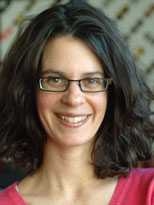When most people look at a rock, they see a lifeless slab. When Dianne Newman looks at one, she sees clues to the history of life on Earth--and potential answers to some of today's medical mysteries.
"You have to look at what we have today and use it to figure out what happened long ago," says Newman, a professor of biology at MIT. "In studying Earth's history, it's very common to look at ancient rocks to infer something about the processes that led to their formation."
Newman, a geobiologist who joined MIT's faculty last year after seven years at Caltech, studies the co-evolution of life and Earth. By focusing on traces left behind by bacteria billions of years ago, she hopes to learn something about ancient Earth and its life forms.
Her work has also led down an unexpected path. She's studying how certain types of anaerobic bacteria thrive in the human body, which could one day help treat infections.
Earlier this year, Newman was named a Howard Hughes Medical Institute investigator, an award that provides unrestricted funding to top researchers to explore topics that may take many years to reach fruition.
Past and present
Geobiologists such as Newman take two complementary approaches to studying ancient Earth and its microbes. One is to analyze rocks containing fossilized deposits of organic and inorganic material; another is to probe the metabolism of modern bacteria.
The second approach is based on the idea that fundamental processes such as cellular metabolism are conserved over time, even billions of years. Half of Newman's laboratory focuses on cyanobacteria and purple bacteria, phototrophic organisms that are assumed to be metabolically not much different from their ancestors that lived billions of years ago.
Cyanobacteria are believed to be the first life forms to produce oxygen from water by photosynthesis--a critical step in making Earth hospitable to life that depends on oxygen. Purple bacteria, on the other hand, grow photosynthetically on substrates other than water and do not produce oxygen.
A few years ago, she and her students isolated a type of modern bacterium, known as Rhodopseudomonas palustris, that performs photosynthesis using ferrous iron, with rust as a byproduct. Similar bacteria are thought to have existed billions of years ago.
"It's great that we can still find and study those bacteria with such bizarre metabolisms," Newman says. "We hope that they will provide us with important clues that will allow us to better interpret the evolution of life in the ancient rock record."
Such bacteria leave behind minerals, which, over time, turn into deposits of iron in rocks such as the one Newman has in her office--a smooth dark sphere with jagged red markings.
That specimen, found in South Africa, is about 2.4 billion years old, but such rocks can range from 3.8 billion to less than 1 billion years old. She hopes to discover how iron deposits were formed during different time periods, which could reveal the composition of the Earth's atmosphere at each time.
To that end, she is studying the modern rust-producing bacteria to determine how iron travels through the cell during photosynthesis, so she can understand the cellular machinery that processes it, in the hope that this will explain the deposits on rocks.
"Dianne's current work, using sophisticated molecular methods to unravel the biosynthesis and physiological roles of molecules that we know can be preserved in rocks over billion-year timescales, underpins geochemical approaches to solving the same problem," said geobiologist Roger Summons, a professor of earth, atmospheric and planetary sciences at MIT.
From Earth to human body
Newman's work, which originally focused on the bacterial metabolisms that affected the chemistry of the environment, may also shed light on how bacteria thrive in the human body. Body wounds often have little oxygen, so the types of bacteria that invade such tissues could be metabolically similar to bacteria that lived on ancient Earth.
"Thinking like geoscientists can help us think about the environment within a wound," she says.
Her lab is studying a bacterium called P. aeruginosa, which often infects the lungs of cystic fibrosis patients and is also found in burn wounds.
P. aeroginusa can survive in environments in the absence of oxygen, and evidence from Newman's lab suggests that a compound called phenazine might be involved in the process. If so, phenazine-processing machinery could become a potential target for drugs to treat P. aeruginosa infections, Newman says.
"We have a long way to go before being able to test this idea, but the hope is that if survival in the lung is influenced by phenazine--or some other electron-shuttling molecule or molecules--tampering with phenazine trafficking might be a potential way to make antibiotics more effective," she says.
A version of this article appeared in MIT Tech Talk on September 10, 2008 (download PDF).






